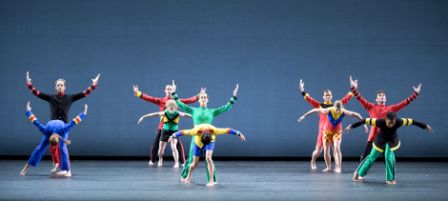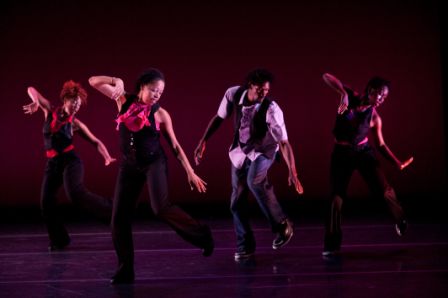foot in mouth: August 2009 Archives
While my colleagues have admitted that something marvelous and strange is going on in Mark Morris's latest works, they've also been diffident. As Alastair Macaulay summed up in the New York Times upon the company's performances at the Mostly Mozart Festival last week,
Both [premieres] are peculiar, imaginative, sincere... But [they] are almost impossible to love.
I recognize that feeling, coming out of a Morris show--principally, a first viewing. But I did love them--if not in a heart-pounding way, then with immediate attention and absorption. Those of you in Berkeley and London still have a chance to catch these two, Empire Garden and Visitation, this fall.
Here, the first few paragraphs of my review, which appeared in the Financial Times' Saturday print edition:
When the Mark Morris troupe was at the Mostly Mozart Festival a few years ago I overheard a small, serious man in a comically oversized suit exult: "The dancing is so... so primitive!" And then, "It's so... so civilised!" Back and forth.Both of him was right. The much-acclaimed Morris can be as blunt in his means as he is meta in his meaning. Take V, reprised this year. The 2001 work to Schumann's Quintet for Piano and Strings, op. 44, not only channels the music's push and pull of plangent joy and stuttery foreboding, it summarises Romanticism itself, in wry, baroquely rational terms.
The effect for the viewer is double vision, as if you were standing both too close, caught inside the dance's gears, and so far away that the dancers are reduced to two dimensions. Only after multiple viewings do these two perspectives merge.
The premieres this year, however, offer a single gratifying experience from the start. Visitation and Empire Garden - touring Berkeley and London in the autumn - return to a more cohesive Morris while elaborating on his increasing richness of expression.
John Heginbotham in Visitation. (Photo, Hilary Scott.)
To Beethoven's Cello Sonata No 4 - played with gorgeous feeling by superstars Emanuel Ax and Yo-Yo Ma, in the pit - the intimate Visitation encloses a wafting ghostliness in foursquare forthrightness, like a high window one leans too far out of, caught up in a vertiginous thrill. Sharply angling their arms as their bodies softly collapse, the dancers pile up contradictions that make immediate sense.
For the whole review, click here.

Empire Garden. (Photo, Gene Schiavone.)
That's what we proved to be--we critics--when Tulsa Ballet hit town, with the governor, Tulsa mayor, secretary of state and members of the Ballet board in tow.
I, at least, was hoping to love them--wouldn't it have been neat to find, far away from any of our dance capitols, that something great was stirring? It happens all the time in the other arts; take, for example, the Flaming Lips, from Norman, OK, not far from Tulsa. (Their fantastically beautiful "Do You Realize?" is now Oklahoma's official rock song! Don't you think The Flaming Lips songs would lend themselves gorgeously to choreography?) But the pieces Tulsa Ballet showcased suffered from the usual problem of mediocre art--that it doesn't join the general to the particular in any exciting or meaningful way. Everything was in outline. The dancers did well, though, as long as they didn't have to go up on point (where they got stuck).
Here's a couple of paragraphs from my Financial Times review:
At first glance, the Tulsa Ballet is not what you'd expect from Oklahoma--for one, because its 27 dancers are all from somewhere else. Directed by Italian Marcello Angelini since 1995, the troupe consists of émigrés from a handful of other states plus South Korea, Colombia, Jamaica, Sweden, Venezuela, the Netherlands, Brazil, Russia, Italy, China, and Japan. "How New York!" I think, impressed to find that the reddest state's governor has flown out--with TV cameras on his tail--for this largely foreign crew.But then the show begins, and though the dancing is fine and sometimes even beautiful, the dances seem as distant from extraordinary as Tulsa is from New York.
Kenneth MacMillan's Elite Syncopations, to Joplin rags, belongs to the seedy-bar genre of Balanchine's Slaughter on Tenth Avenue or Tudor's Judgment of Paris. But Tudor and Balanchine endow their guns- and bodies-for-hire with a level of detail that wrings pathos out of the world-weary scene; Macmillan merely comments on the category, as if completing a school essay test: "If ragtime were ballet, what would it look like? 30 minutes." Nevertheless, Kate Oderkirk and company star Karina Gonzalez pour themselves into the steps for a very sexy slitheriness.
Soon Young Hue's This is Your Life, created on the Tulsa dancers last year, is still more disappointing, because the South Korean choreographer's New York debut actually starts from a promising conceit.....
For the whole piece, click here.
****
For more "elitist" crankiness, read Alastair Macaulay's heartfelt belly-aching (as my farmer grandfather would put it) about the So You Think You Can Dance/Dancing with the Stars phenomenon, here. I've been wanting to write this piece forever, and probably because I knew it would seem hopelessly snobby--I can't tell you how many people whose only exposure to dance are these shows ask me eagerly what I think of them--somehow haven't. I just say I haven't watched them much, which is true enough, but the reason is that they give me a stomachache.
Macaulay says, in short, that they strip all the forms they steal from of their dance. I agree, and it makes me sad that we couldn't see some real mambos and rumbas and waltzes, with their breath and ecstasy. I think viewers would love them even more. I have to believe that, of course.
Fast forward to about the one minute mark on this trailer for Henry Chalfant's great movie Mambo to Hip Hop, and you'll see what we're missing. Look at the spell this couple are putting on each other--that's what the man's body wave is about, not just a move--and the pace at which they do it lets you feel it, too. I love the way they start by touching foreheads: it's so intimate.
The Financial Times wanted a piece that explained the Pillow as well as reviewing the week's attractions for people not already in the know. A fun assignment, especially as it gave me an excuse (and the means) to go up there for the first time. I thought it was only California that you could drive in for miles and still be nowhere near the border.
Here's a few paragraphs, taken from the middle of the piece, about Rennie Harris PureMovement, which performs there through Sunday. (Isn't "Adidas workout trousers" the most adorable Britishism you ever have heard?):
In spite of the range of offerings, a common thread does run through this year's Festival: hip-hop. The form is so pervasive that it has transcended its original values and circumstances. The Canadian troupes Rubberbandance (August 9-12) and Kidd Pivot (August 19-23), for example, use the low-riding, sideways-loping legs, the jigsaw body and the pliant use of the floor to create delicate interior worlds.
Rennie Harris, whose PureMovement troupe is this week's main attraction, has probably done more to make that expansion possible than anyone. The one-time dancer for Run-DMC and Kurtis Blow has turned hip-hop towards narrative, with a West Side Story set in present-day North Philadelphia, where he grew up. He's tackled big social questions via dancing as silken as a cloudy midnight. And he's masterminded a variety show that demonstrates how rapping, DJing, bucket-drumming and so forth form a whole with b-boy tricks and hip-hop steps. But whatever he's done, Harris has never forgotten the form's social origins.
"Students of the Asphalt Jungle" (1995)-- one of three early works on the programme-- begins with eight buff men in Adidas work-out trousers crouched in a sprinter's start. They blast off into b-boy manoeuvres, presented in the usual fashion: one dancer at a time trying to outdo the rest, spinning like a disc, tumbling through enough flip-flops to turn into a blur, tying himself into a tangled knot. The other men lie on their stomachs in push-up position with noses and eyes pressed to the floor. Harris doesn't offer hip-hop exhibitionism and machismo blindly. He's wondering, What's driving us-- or who-- and what are we getting for our effort? The audience on Wednesday didn't hear the troubling question. They cheered wildly at the spectacular moves.
Click here for the whole piece.

AJ Blogs
AJBlogCentral | rssculture
Terry Teachout on the arts in New York City
Andrew Taylor on the business of arts & culture
rock culture approximately
Laura Collins-Hughes on arts, culture and coverage
Richard Kessler on arts education
Douglas McLennan's blog
Dalouge Smith advocates for the Arts
Art from the American Outback
Chloe Veltman on how culture will save the world
For immediate release: the arts are marketable
No genre is the new genre
David Jays on theatre and dance
Paul Levy measures the Angles
Judith H. Dobrzynski on Culture
John Rockwell on the arts
innovations and impediments in not-for-profit arts
Jan Herman - arts, media & culture with 'tude
dance
Apollinaire Scherr talks about dance
Tobi Tobias on dance et al...
jazz
Howard Mandel's freelance Urban Improvisation
Focus on New Orleans. Jazz and Other Sounds
Doug Ramsey on Jazz and other matters...
media
Jeff Weinstein's Cultural Mixology
Martha Bayles on Film...
classical music
Fresh ideas on building arts communities
Greg Sandow performs a book-in-progress
Harvey Sachs on music, and various digressions
Bruce Brubaker on all things Piano
Kyle Gann on music after the fact
Greg Sandow on the future of Classical Music
Norman Lebrecht on Shifting Sound Worlds
Joe Horowitz on music
publishing
Jerome Weeks on Books
Scott McLemee on books, ideas & trash-culture ephemera
theatre
Wendy Rosenfield: covering drama, onstage and off
visual
Public Art, Public Space
Regina Hackett takes her Art To Go
John Perreault's art diary
Lee Rosenbaum's Cultural Commentary

Recent Comments